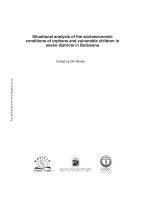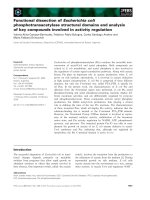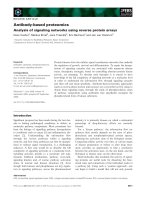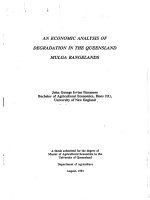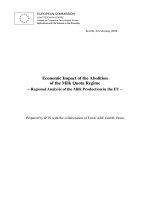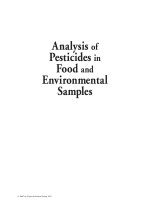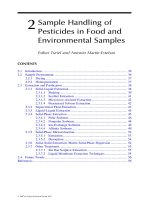Proteomics analysis of pseudomonas putida in biodegradation of aromatic compounds
Bạn đang xem bản rút gọn của tài liệu. Xem và tải ngay bản đầy đủ của tài liệu tại đây (2.29 MB, 212 trang )
PROTEOMICS ANALYSIS OF PSEUDOMONAS PUTIDA
IN BIODEGRADATION OF AROMATIC COMPOUNDS
CAO BIN
NATIONAL UNIVERSITY OF SINGAPORE
2007
PROTEOMICS ANALYSIS OF PSEUDOMONAS PUTIDA IN
BIODEGRADATION OF AROMATIC COMPOUNDS
CAO BIN
(B. Eng., Beijing University of Aeronautics and Astronautics, China)
A THESIS SUBMITTED
FOR THE DEGREE OF DOCTER OF PHILOSOPHY
DEPARTMENT OF CHEMICAL AND BIOMOLECULAR
ENGINEERING
NATIONAL UNIVERSITY OF SINGAPORE
2007
i
ACKNOWLEDGEMENTS
In the current scientific realm, no research endeavor is ever carried out in
solitude. This thesis would not have been possible without the assistance and
encouragements of many individuals to whom I owe my deepest gratitude.
First and foremost, I would like to thank my thesis advisor, Associate
Professor Loh Kai-Chee for giving me the opportunity to work in the very interesting
and exciting interdisciplinary research field of Proteomics and Biodegradation. My
deepest gratitude is expressed for his scientific guidance, continuous support and
encouragement during my years at NUS.
I would like to thank all my former and current labmates, including Dr. Geng
Anli, Dr. Li Yi, Mr. Ne Lin, Ms. Wu Tingting, Ms. Karthiga Nagarajan, Mr. Satyen
Gautam, Mr. Vivek Vasudevan, and Mr. Bulbul Ahmed for the helpful discussions
and for their assistance during my PhD study.
Ms. Chow Pek and Ms. Chew Su Mei Novel, our former and current lab
officer, respectively; Mr. Han Guangjun and Ms. Li Xiang, the professional officer
and lab officer for bio-research facilities, respectively, deserve separate
acknowledgements. Their assistance and support made my life easier in the
laboratories.
I would like to thank my parents and my wife for their love and support. They
are always beside me whenever I need encouragements.
ii
Last but not least my special thanks go to Dr. Peng Zanguo for his support in
both academic and non-academic areas and for being a helpful friend on whom I can
always count.
This work was supported by a research grant from the Ministry of Education
Academic Research Fund (R-279-000-181-112). I also want to thank NUS for the
research scholarship provided to me. I am also grateful for the generous NIH-AES
travel grants from the American Electrophoresis Society, which provided invaluable
opportunities for me to attend the AIChE Annual Meetings to present my work and
learn from the international community.
iii
TABLE OF CONTENTS
ACKNOWLEDGEMENTS i
TABLE OF CONTENTS iii
SUMMARY vi
LIST OF TABLES ix
LIST OF FIGURES xi
LIST OF ABBREVIATIONS AND SYMBOLS xiv
1 INTRODUCTION 1
1.1 Research Background and Motivations 1
1.2 Research Objectives and Scope 5
1.3 Thesis Organization 6
2 LITERATURE REVIEW 7
2.1 Aromatic Pollutants and Bioremediation 7
2.2 Bacterial Utilization of Aromatic Pollutants 11
2.2.1 Major Bacteria 11
2.2.2 Biodegradation Mechanisms 13
2.2.3 Current Status 19
2.2.4 Molecular Biology 35
2.3 Proteomics Technologies in Bioremediation 48
2.3.1 Proteomics Technologies 48
2.3.2 Proteomics and Bioremediation 60
2.4 Proteomics Studies of P. putida 63
2.4.1 Introduction 63
2.4.2 Proteomics Approaches Used to Study P. putida 65
2.4.3 Elucidation of Catabolic Pathways 72
2.4.4 Understanding physiological responses 78
3
MATERIALS AND METHODS 84
3.1 Bacterial Strains 84
iv
3.2 Culture Media and Growth Conditions 84
3.3 Cell Growth and 2-Hydroxymuconic Semiadehyde Formation 86
3.4 Preparation of Cell Extracts 86
3.5 Catechol Dioxygenases Assays 87
3.6 Determination of Protein Concentration 87
3.7 2-DE 88
3.8 Gel Staining 89
3.8.1 Silver Stain Plus Kit (Bio-Rad) 89
3.8.2 Bio-Safe Coomassie Stain 90
3.8.3 Destaining 90
3.9 Quantitative Analysis 91
3.10 In-gel Digestion and Peptides Extraction 92
3.11 Protein Identification by MS 93
4 METABOLIC PATHWAY AND CELLULAR RESPONSES OF P. PUTIDA
DURING GROWTH ON BENZOATE 95
4.1 Introduction 95
4.2 Experimental Design 98
4.2.1 Sample Description 98
4.2.2 Quantitative Analysis 98
4.2.3 Bioinformatics Tools 98
4.3 Results and Discussion 99
4.3.1 Benzoate Catabolic Pathways in P. putida P8 99
4.3.2 Stress Responses of P. putida P8 to Growth on Benzoate 122
4.3.3 Adaptation of Other Metabolic Routes to Growth on Benzoate 125
4.4 Concluding Remarks 130
5 GLOBAL PHYSIOLOGICAL UNDERSTANDING OF P. PUTIDA IN
BIPHASIC GROWTH ON A MIXTURE OF PHENOL, 4-CHLOROPHENOL AND
SODIUM GLUTAMATE 131
5.1 Introduction 131
5.2 Experimental Design 133
v
5.2.1 Sample Description 133
5.2.2 Quantitative Analysis 133
5.3 Results and Discussion 133
5.3.1 Biphasic Growth of P. putida P8 133
5.3.2 Analysis of Proteome Profiles 135
5.3.3 Differentially Expressed Catabolic Enzymes 142
5.3.4 Other Metabolic Changes 142
5.4 Concluding Remarks 148
6 COMETABOLISM OF CARBAZOLE IN PRESENCE OF SALICYLATE
AND P-CRESOL: GLOBAL PHYSIOLOGICAL RESPONSES OF P. PUTIDA
ATCC 117484 149
6.1 Introduction 149
6.2 Experimental Design 151
6.2.1 Sample Description 151
6.2.2 Quantitative Analysis 151
6.3 Results and Discussion 151
6.3.1 Cell Growth 151
6.3.2 Proteome Analysis of P. putida ATCC 17484 153
6.3.3 Global Physiological Responses 153
6.4 Concluding Remarks 160
7 CONCLUSIONS AND RECOMMENDATIONS 161
7.1 Conclusions 161
7.2 Recommendations for Future Work 163
REFERENCES 166
LIST OF PUBLICATIONS AND PRESENTATIONS 192
LIST OF AWARDS 194
vi
SUMMARY
Although proteomics research has been, hitherto, confined mainly to areas of
drug discovery, diagnostics and molecular medicine, it offers a new and important
perspective for studies of microbial physiological responses in biodegradation
systems. Proteomics has been applied to elucidate biodegradation pathways, to
monitor physiological consequences after metabolic engineering, and to advance the
understanding of microbial growth and adaptation to mixed pollutants. In this research,
proteomics analysis was used to study three previously reported phenomena in
biodegradation involving Pseudomonas putida.
The three model systems selected were: i) biodegradation of benzoate by P.
putida P8 at high substrate concentration; ii) cometabolic biodegradation of phenol, 4-
chlorophenol and sodium glutamate by P. putida P8; and iii) cometabolic
biodegradation of carbazole, sodium salicylate and p-cresol by P. putida ATCC
17484. Two-dimensional gel electrophoresis (2-DE) was used to separate proteins
extracted from P. putida cells harvested from the biodegradation systems. The 2-DE
gel profiles were quantitatively compared using threshold criteria and statistical tools.
Protein spots of interest were identified through database searching based on peptide
mass fingerprints (PMFs) obtained using matrix assisted laser desorption/ionization-
time of flight mass spectrometry (MALDI-TOF MS).
In the first system, eight catabolic enzymes involved in both the ortho-
cleavage (CatB, PcaI and PcaF) and the meta-cleavage (DmpC, DmpD, DmpE, DmpF
and DmpG) pathways for benzoate biodegradation were identified in P. putida grown
on 800 mg/L of benzoate while no meta-cleavage pathway enzymes were observed in
vii
the 2-DE gel profiles of P. putida grown on 100 mg/L of benzoate. The activation of
both the ortho- and the meta-cleavage pathways in P. putida P8 grown on high
benzoate concentration was confirmed directly at the protein level. Furthermore, the
down-regulation of the ortho-cleavage pathway in P. putida cells grown on 800 mg/L
of benzoate compared to those grown on 100 mg/L of benzoate was suggested. In
addition, another 28 differentially expressed proteins were also identified, including
proteins involved in i) detoxification and stress response (AhpC, ATPase-like ATP-
binding region, putative DNA-binding stress protein, SodB and catalase/peroxidase
HPI); ii) carbohydrate, amino acid/protein and energy metabolism (isocitrate
dehydrogenase, SucC, SucD, AcnB, GabD, ArcA, ArgI, Efp and periplasmic binding
proteins of several ABC-transporters); and iii) cell envelope and cell division
(bacterial surface antigen family protein and MinD). Based on the data obtained,
physiological changes of P. putida in response to growth on benzoate at different
concentrations were discussed.
A total of 49 protein spots were selected and identified in the 2-DE gels from
P. putida P8 grown on the ternary substrate cometabolic system containing 200 mg/L
of phenol, 200 mg/L of 4-chlorophenol and 1000 mg/L sodium glutamate. Among
them, 16 protein spots were found differentially expressed in the two exponential
growth phases during the biphasic growth, including 6 catabolic enzymes (DmpC,
DmpD, DmpE, DmpF, DmpG and AspA) for substrate utilization. The expression
levels of these enzymes during growth in the two growth phases correlated well with
the substrate utilization patterns observed in previous kinetics studies. The expression
of other proteins involved in detoxification and stress responses (DnaK, GroEL, HtpG
and AhpC etc.), carbohydrate and energy metabolism (AtpD, AtpH, Tal, Eno), and
environmental information processing (several periplasmic binding proteins of ABC
viii
transporters) as well as a multifunctional xenobiotic reductase (XenA) was
quantitatively analyzed and discussed.
In the final model system, 25 protein spots were identified in P. putida
ATCC 17484 during growth in the ternary substrate cometabolic biodegradation
system of carbazole (0.5 mg/L), sodium salicylate (200 mg/L) and p-cresol (10 mg/L
or 70 mg/L). There were significant differences in the abundances of 8 proteins during
growth at two typical p-cresol concentrations (10 mg/L and 70 mg/L). Specifically,
GalU and beta-ketothiolase were involved in the biosynthesis of cell envelope and
cytoplasmic membrane; GlnA and periplasmic putrescine-binding component of
putrescine ABC transporter were involved in amino acid metabolism, and aldehyde
dehydrogenase (ALDH) family protein was involved in the substrate utilization.
Collectively, these results enhanced our understanding of the catabolic
pathways and the physiological status of P. putida during biodegradation of aromatic
compounds. A comprehensive understanding of the bacterial physiology during
biodegradation processes may provide useful insights into effective approaches to
stimulate or prepare the microorganism for in situ bioremediation applications.
ix
LIST OF TABLES
Table 2-1 Summary of environmental pollution in the ecosystem 7
Table 2-2 Representative aromatic compounds in the environment 8
Table 2-3 Representative aromatic pollutants and their MCLs
a
(mg/L) 9
Table 2-4 Common bioremediation technologies (Watanabe 2001) 10
Table 2-5 Major groups of anaerobic bacteria in aromatic biodegradation 11
Table 2-6 Bacterial utilization of aromatic compounds 14
Table 2-7 Enzymes associated with biodegradation of aromatic compounds (extracted
from Whiteley and Lee (2006)) 17
Table 2-8 PAH-degrading bacteria 22
Table 2-9 Gene clusters encoding chlorobenzoate catabolic pathways 30
Table 2-10 Bioremediation of aromatic pollutants using biofilm reactor 33
Table 2-11 Catabolic plasmids for biodegradation of aromatic compounds (adapted
from Dennis (2005)) 36
Table 2-12 Modified catabolic enzymes for biodegradation of aromatic compounds 42
Table 2-13 Comparison of local and global analysis approaches 44
Table 2-14 Representative transcriptome and metabolome analysis 47
Table 2-15 Gel-free proteomics strategies 53
Table 2-16 Main quantitative strategies in gel-free proteomics 54
Table 2-17 Commonly used search engines and databases 57
Table 2-18 Major proteome databases and resources 60
Table 2-19 Current status of genome-sequencing projects for Pseudomonas species 64
x
Table 2-20 Summary of proteomics projects on P. putida 66
Table 2-21 Enzymes identified in aromatic catabolic pathways of P. putida and some
other environmental bacteria 74
Table 3-1 Biodegradation systems investigated 85
Table 3-2 Database search conditions 94
Table 4-1 Identification of protein spots that were found changed in abundance by a
threshold of 1.5-fold in P. putida grown on 800 mg/L of benzoate compared with
succinate-grown cells. Differentially expressed proteins with a p-value of 0.05 in
the Student’s t-test are highlighted in bold. 101
Table 4-2 Identification of catabolic enzymes involved in benzoate degradation 111
Table 4-3 Some key enzymes in catabolic pathways for aromatic compounds
identified through proteomics approaches 114
Table 4-4 Catabolic pathways for benzoate degradation by Pseudomonas species 116
Table 4-5 Differentially expressed chaperones and detoxification/oxidative stress
response proteins in P. putida P8 during benzoate degradation. 122
Table 4-6 Identification of several periplasmic proteins and their corresponding
predicted transmembrane segments. 129
Table 5-1 Identification of protein spots found changed in abundance by a threshold
of 1.5-fold in P. putida grown in GP-II compared with GP-I. Among them,
differentially expressed proteins with a p-value of 0.05 in Student’s t-test are
highlighted in bold. 137
Table 5-2 Functional categories and the involved biological processes (obtained from
KEGG database) of the differentially expressed proteins. 141
Table 6-1 Identification of protein spots that were found changed in abundance by a
threshold of 1.5-fold (H vs. L) in P. putida. Among them, differentially
expressed proteins with a p-value of 0.05 in Student’s t-test are highlighted in
bold. 155
xi
LIST OF FIGURES
Figure 1-1 Growth in the number of publications available through PubMed
( 2
Figure 2-1 Aromatic compounds funneled to (a) catechol and (b) protocatechuate.
Major aerobic routes of the aromatic-ring cleavage: (c) ortho-, meta-, and
gentisate cleavage (Harwood and Parales 1996). 15
Figure 2-2 (a) Anaerobic degradation pathways for petroleum hydrocarbon, BTEX
(Chakraborty and Coates 2004). A, Fumarate (HOOCCH=CHCOOH); E
1
,
benzylsuccinate synthase (BSS); E
2
, ethylbenzylsuccinate synthase; E
3
,
ethylbenzene dehydrogenase; E
4
, ethylbenzylsuccinate synthase; E
5
, benzoyl-
CoA reductase. (b) Aerobic hybrid pathway for the catabolism of phenylacetate
(Diaz 2004). 18
Figure 2-3 Main catabolic pathways for PAHs degradation by fungi and bacteria
(Cerniglia 1992). 21
Figure 2-4 Main pathway in aerobic biodegradation of naphthalene by bacteria
(Bamforth and Singleton 2005). 21
Figure 2-5 (a) The proposed initial pathway for anaerobic naphthalene degradation
under sulfate-reducing conditions; (b) the proposed upper pathway of anaerobic
degradation of 2-methylnaphthalene (1) to the central intermediate 2-naphthoic
acid (8). Compounds marked with an asterisk were identified as free acids. 25
Figure 2-6 Biphenyl degradation pathway (Yoshiyuki et al. 2004). 28
Figure 2-7 Pathways for the degradation of chlorobenzoates. Initial metabolic steps of
a 3- and 4-chlorobenzoate degradation involving benzoate or toluate 1,2-
dioxygenase, b 2-chloro- and 2,5-dichlorobenzoate involving 2-halobenzoate
1,2-dioxygenase, c 4-chlorobenzoate involving hydrolytic dehalogenation, and d
3-chloro- and 3,4-dichlorobenzoate involving 4,5-dioxygenation are shown.
Unstable intermediates are enclosed in brackets. Taken from Pieper (2005). 29
Figure 2-8 Pathways for the degradation of chlorocatechols. C230 Catechol 2,3-
dioxygenase, CC23O chlorocatechol 2,3-dioxygenase, C12O catechol 1,2-
dioxygenase, CC12O chlorocatechol 1,2-dioxygenase, MCI muconate
cycloisomerase, CMCI
P
proteobacterial chloromuconate cycloisomerase, CMCI
R
chloromuconate cycloisomerase, MLI muconolactone isomerase, CMLI
R
chloromuconolactone isomerase, DLH
P
proteobacterial dienelactone hydrolase,
DLH
R
dienelactone hydrolase, tDLH trans-dienelactone hydrolase, MAR
maleylacetate reductase. Unstable intermediates are enclosed in brackets. Taken
from Pieper (2005). 31
xii
Figure 2-9 Assembly of a novel pathway for biodegradation of 2-chlorotoluene by
engineered Pseudomonas strains. The toluene dioxygenase (TOD) enzyme of P.
putida F1 on ortho-substituted toluene (encoded by the todC1C2BA genes) is
employed to convert 2-chlorotoluene into 2-chlorobenzylalcohol. Then the TOL
upper pathway genes xylB and xylC convert it all the way to 2-chlorobenzoate.
Finally, the P. aeruginosa strains that host the engineered pathway have an
intrinsic ability to consume 2-chlorobenzoate. P. aeruginosa JB2 seems to
degrade this compound through a pathway that involves production of a 3-
chlorocatechol intermediate that can be funneled towards a modified ortho-
cleavage pathway. On the contrary, strain P. aeruginosa PA142 makes a 1,2-
dioxygenation that results in formation of plain catechol. This can be entered as
such in the housekeeping ortho-cleavage pathway. Taken from Haro and de
Lorenzo (2001) 38
Figure 2-10 (a) The rational design process and (b) the directed evolution process. 41
Figure 2-11 (A) Traditional central dogma of molecular biology where the flow of
information goes from gene to transcript to protein, also shown is where
enzymes act on metabolism. (B) General schematic of the omic organization
where the flow of information is from genes to transcripts to proteins to
metabolites to function (or phenotype). (C) Traditional linear view of a metabolic
pathway and the now accepted view of scale-free connections in a metabolite
neighborhood; nodes are metabolites, whilst the connections represent enzymatic
action. Taken from Hollywood et al. (2006). 45
Figure 2-12 Technical principles of MS technologies in proteome analysis. (A)
ionization by MALDI; (B) ionization by ESI; (C)-(F) mass analyzers (Hufnagel
and Rabus 2006). 49
Figure 2-13 A mixture of four identical peptides each labeled with one member of the
multiplex set appears as a single, unresolved precursor ion in MS (identical m/z)
(i). Following CID, the four reporter group ions appear as distinct masses (114–
117 Da) (ii). All other sequence-informative fragment ions (b-, y-, etc.) remain
isobaric, and their individual ion current signals (signal intensities) are additive
(iii and iv). The relative concentration of the peptides is thus deduced from the
relative intensities of the corresponding reporter ions (ii) (Ross et al. 2004). 55
Figure 4-1 A representative 2-D gel (IPG strip pH 4-7, SDS-PAGE 12% acrylamide)
of P. putida cells grown on 800 mg/L of benzoate. Spot numbers were generated
by PDQuest. 100
Figure 4-2 (a) Growth profiles of P. putida P8 in 100 mg/L (○) and 800 mg/L (□)
benzoate. (b) A
375
profiles of cell-free filtrate during biodegradation. 106
Figure 4-3 Activity assay of catechol 1,2-dioxygenase (C12D) and catechol 2,3-
dioxygenase (C23D); N.D., not detected. 108
xiii
Figure 4-4 Expression of 8 identified key catabolic enzymes in benzoate degradation
in cells grown on 100 mg/L benzoate (L), 800 mg/L benzoate (H), and succinate
(S). 109
Figure 4-5 Proposed catabolic pathways for benzoate degradation by P. putida P8.
Enzymes are represented by their EC numbers. Identified enzymes are
underlined and noted with their corresponding spot numbers. Enzymes
underlined and in italics are those whose activities have been confirmed
experimentally. DHB, 1,2-dihydro-1,2-dihydroxybenzoate; 2-HMSA, 2-
hydroxymuconic semialdehyde. 118
Figure 5-1 Cometabolic transformation of 4-cp (200 mg/L) by P. putida P8 using
phenol (200 mg/L) and sodium glutamate (1000 mg/L) as growth substrates. (a)
Cells were harvested at GP-I and GP-II; (b) Estimated consumption of individual
substrates during the biphasic growth. Lag, lag phase; Log-I, first growth phase;
i-Lag, intermediate lag phase; Log-II, second growth phase. Adapted from Wang
and Loh (2000). 134
Figure 5-2 Comparison of 2-DE gels containing proteins from P. putida harvested
from (a) GP-I and (b) GP-II. The numbers are the Standard Spot Numbers
assigned by PDQuest. Numbered spots in (b) were found to have at least 1.5-fold
greater intensities compared to spots in the equivalent positions of the other gel;
among these, those identified in gel (a) were found differentially expressed with
p<0.05. 136
Figure 5-3 Catabolism of phenol and glutamate in the ternary cometabolic system by
P. putida P8. The 6 identified key enzymes are highlighted in the boxes. 143
Figure 6-1 P. putida ATCC 17484 cell growth profiles during biodegradation of
carbazole, sodium salicylate and p-cresol. Data shown correspond to 0.5 mg/L
carbazole, 200 mg/L sodium salicylate and 10 mg/L p-cresol (●) or 70 mg/L (▲)
p-cresol. Harvesting points were annotated with “P”. 152
Figure 6-2 2-DE of proteins extracted from P. putida ATCC 17484 grown in 0.5 mg/L
carbazole, 200 mg/L sodium salicylate and (a) 10 mg/L p-cresol or (b) 70 mg/L
p-cresol. Gels were sliver stained. A total of 25 spots (annotated in gel (a)) were
selected based on the 1.5-fold threshold; among them, 8 (annotated in gel (b))
were observed to differ significantly in abundance (p<0.05). 154
xiv
LIST OF ABBREVIATIONS AND SYMBOLS
A
Absorbance
ACN
Acetonitrile
APS
Ammonium persulfate
ATCC
American Type Culture Collection
a.u.
Absorbance Unit
Bis
N,N’-methylenebisacrylamide
BLAST
Basic Local Alignment Search Tool
%C
Cross-linking agent (g/100 mL)/%T
CBB
Colloidal brilliant blue
C12D
Catechol 1,2-dioxygenase
C23D
Catechol 2,3-dioxygenase
CF
Chromatofocusing
CHAPS
3-[(3-Cholamidopropyl)dimethylaminio]-1-propanesulfonate
CHCA
α-Cyano-4-hydroxycinnamic acid
1-D
One-dimensional
2-D
Two-dimensional
Da
Dalton (molecular mass)
2-DE
Two-dimensional gel electrophoresis
DIGE
Fluorescence difference gel electrophoresis
DTT
Dithiothreitol
ESE
Environmental science and engineering
ESI
Electrospray ionization
GC
Gas-chromatography
xv
2-HMSA
2-Hydroxymuconic semialdehyde
HPLC
High-performance liquid chromatography
IEF
Isoelectric focusing
IPG
Immobilized pH gradient
kDa
Kilodalton (molecular mass)
LC
Liquid chromatography
MALDI
Matrix-assisted laser desorption/ionization
MCL
Maximum contaminant level
M
r
Relative molecular mass (dimensionless)
MS
Mass spectrometry
MS/MS
Tandem mass spectrometry
m/z
Mass-to-charge ratio
NCBI
National Center for Biotechnology Information
OD
Optical density
PAGE
Polyacrylamide gel electrophoresis
PAH
Polyaromtaic hydrocarbon
PCB
Polychlorinated biphenyl
PCP
Pentachlorophenol
PCR
Polymerase chain reaction
pI
Isoelectric point
PMF
Peptide mass fingerprinting
PSD
Post-source decay
PTM
Post-translational modification
RP
Reverse phase
rpm
Revolutions per minute
xvi
SCX
Strong cation exchange
SD
Standard deviation
SDS
Sodium dodecyl sulfate
S/N
Signal-to-noise ratio
SNAP
Sophisticated numerical annotation procedure
ROS
Reactive oxygen species
%T
Total gel concentration (acrylamide plus cross-linking agent; g/100 mL)
TEMED
N,N,N’,N’-tetramethylethylenediamine
TFA
Trifluoroacetic acid
TOF
Time-of-flight
Tris
Tris(hydroxymethyl)aminomethane
U
Unit (enzyme activity)
UV
Ultraviolet
Vh
Volt × hours
WWW
World Wide Web
1
1 INTRODUCTION
This Chapter begins with a brief introduction of the research background.
Thesis objectives and scope are then presented. Finally, the organization of the thesis
is introduced.
1.1 Research Background and Motivations
Since the first bacterial genome of Haemophilus influenzae was completely
sequenced in 1995, 435 bacterial genome-sequencing projects have been completed
and around 700 are under way (www.ncbi.nih.gov). The analysis of genomic data has
without doubt revealed the immense complexity of microorganisms in nature.
However, the genome of an organism only gives a static overview of its functional
potential, from which not much more information can be derived. For an organism,
even if all the cells contain identical genetic information, the expression of the
different genes into proteins takes place during different developmental stages or
under different environmental conditions. On the other hand, it is their intracellular
proteins, not their genes, which are responsible for the phenotypes of cells. It is
impossible to elucidate the effects of environmental conditions by studying the genes
alone. Proteomics (complementary to genomics), which deals with the high-
throughput analysis of gene products directly at the protein level, offers this
possibility. Unlike the static genome, the proteome is dynamic, changing with time
and environment, and it describes the dynamic process that occurs within a living
organism. By correlating the differences in proteome patterns with biological effects,
proteome analysis can provide a lot of useful information that currently cannot be
obtained by other techniques.
2
Proteomics is an exciting new science and the growth of this field is expected
to parallel that of genomics. Proteomics technologies currently play an important role
in drug discovery, diagnostics, and molecular medicine. Judging from the number of
journal publications that involved proteomics in their research (Figure 1-1), with an
exponential growth rate, proteomics will become more and more attractive not only in
medical sciences but also in interdisciplinary research areas such as biochemical
engineering, and environmental biotechnology.
Figure 1-1 Growth in the number of publications available through PubMed
(
In environmental science and engineering (ESE), biodegradation has been
widely studied on the basis of degradation kinetics and treatment efficiency.
Knowledge of biodegradation kinetics is vital for the design of bioreactors and the
prediction of the fate of the pollutants during the waste treatment process.
Characterization of phenotypic changes within the bacteria is also an important aspect.
This has so far been ignored, due mainly to the lack of appropriate analytical
0
500
1000
1500
2000
2500
3000
3500
4000
4500
5000
1995 1996 1997 1998 1999 2000 2001 2002 2003 2004 2005 2006
Year
Publications
"Proteome/Proteomic/Proteomics"
3
instrumentation. Proteomics is a good complementary tool to kinetics analysis of
biodegradation systems. By applying proteomics methods to biodegradation, a more
comprehensive understanding of the biodegradation systems can be obtained.
Proteomics can provide critical insights into the biodegradation kinetics of a pollutant
mixture and the physiological responses of the bacteria during the biodegradation
process. For example, through proteomics analysis of the microorganisms,
information on the mechanisms of defense, detoxification and adaptation to chemicals
can be obtained. Proteome profiling of the microorganisms will generate valuable
knowledge that can be used to enhance biodegradation through metabolic and cellular
engineering, and also to increase degradation efficiency in waste treatment processes
through optimized environmental conditions for bacterial growth.
Currently, the application of proteomics methods to biodegradation research is
still at its infancy; very little of this research is currently available in the literature. In
bioremediation, the genus Pseudomonas and the species P. putida, in particular, are
paradigms due to their extraordinary capabilities in degrading aromatic compounds. It
is exciting to note that the genome of Pseudomonas putida KT2440 was completely
sequenced and recently published in 2002 (Nelson et al. 2002), which makes
physiological understanding of P. putida based on proteome analysis feasible. Using
proteomics tools, some interesting biodegradation phenomena previously reported in
P. putida can now be elucidated at the protein level. For example, in studying the
biodegradation of benzoate, it was found that a switch in degradation pathway
(between meta-cleavage and the ortho-cleavage pathways) was observed when the
bacteria cells were grown in different initial benzoate concentrations (Loh and Chua
2002). This phenomenon was explained through an indirect inference of the metabolic
pathway via experimental observations. A more direct proof of this is necessary, and
4
this can only be obtained through an analysis of the underlying proteins involved in
the benzoate degradation pathway.
In another study involving the cometabolic transformation of 4-chlorophenol
(4-cp) in the presence of the specific growth substrate, phenol, and the conventional
carbon source, sodium glutamate (SG), it was found that under certain unique
concentration combinations of the three substrates, a biphasic growth pattern resulted
(Wang et al. 2003; Wang and Loh 2000). Through experimentation and kinetics
modeling, it was inferred that this was due to the disparity of the toxicity of 4-cp to
phenol-oxidizing and SG-oxidizing enzyme activities. While this was sufficiently
accepted, it is rather general in its meaning. This system offers proteomics analysis an
excellent model to justify the power of the tool to biodegradation research.
Another demonstration, the inhibition of p-cresol to the cometabolic
transformation of carbazole in the presence of salicylate was observed (Yu and Loh
2002). With different initial p-cresol concentrations, the inhibition levels were
reported to be different. The cellular responses of the P. putida cells to p-cresol in this
complex biodegradation system can be obtained using proteomics tools. Although
there are many challenges, the future of the applications of proteomics to
biodegradation research to obtain the physiological responses is promising. Based on
research that is reported in the literature, it is clear that proteomics is becoming
attractive to ESE researchers.
5
1.2 Research Objectives and Scope
The overall objective of this research was to apply proteomics tools to
biodegradation in order to elucidate the physiological responses of P. putida during its
biodegradation of aromatic compounds.
Specifically, the research programme comprised the following:
1) Elucidate the degradation pathways and obtain the cellular responses of P.
putida P8 during growth on benzoate;
2) Understand the physiological changes of P. putida P8 during the biphasic
growth on 4-cp in the presence of phenol and sodium glutamate;
3) Obtain molecular insights into the inhibition of p-cresol to the cometabolic
transformation of carbazole in the presence of salicylate by P. putida ATCC
17484.
The research conducted here was an initial demonstration of the power of
proteomics in environmental science applications, which investigated biodegradation
systems at the protein level only. Although information that can be obtained at the
gene and the mRNA levels is also very important, it is important to note that direct
manipulation of specific genes or the use of genetic engineering methods to create
mutated species is outside of the current research scope.
The results obtained from this research would advance the understanding of
biodegradation processes involved in waste water treatment. The physiological
information obtained during the respective biodegradation processes would contribute
to the development of novel environmental biotechnological processes.
6
1.3 Thesis Organization
This thesis comprises seven chapters. Chapter 1 provides a brief introduction
and outlines the research background and objectives of this thesis. Published research
in biodegradation of aromatic compounds and the current status of the state-of-the-art
techniques in proteomics and the applications of proteomics in biodegradation are
extensively reviewed in Chapter 2. Chapter 3 details the materials and methods used
in this research. Chapter 4 presents the results obtained from a proteomics study
focused on the biodegradation of benzoate to elucidate the degradation pathways and
the cellular responses of P. putida during the pathway switch. Chapter 5 presents the
proteome analysis of P. putida in the cometabolic system of 4-cp, benzoate, and
sodium glutamate to elucidate the physiological changes during the biphasic growth.
The physiological responses of P. putida to p-cresol inhibition on the cometabolic
degradation of carbazole and salicylate are discussed in Chapter 6. Finally, Chapter 7
summarizes the important findings and conclusions from Chapters 4 to 6 and several
recommendations for future work.
7
2 LITERATURE REVIEW
In this literature review, aromatic pollutants and their bioremediation are first
introduced, followed by a brief review of the current status and molecular biology of
aromatic biodegradation. These provide the fundamentals on which to base the
discussion of the results obtained in this research programme. The concepts and
current status of proteomics technologies and application in biodegradation studies are
then reported. Finally, proteomics studies for P. putida are discussed and the key
findings from proteome analyses are summarized.
2.1 Aromatic Pollutants and Bioremediation
Environmental pollutants released into the ecosystem, as a consequence of
human activities, are usually compounds which are toxic to living organisms. Some of
the major sources of environmental pollution in the ecosystem are summarized in
Table 2-1.
Table 2-1 Summary of environmental pollution in the ecosystem
Major sources Environmental pollution
Chemical and pharmaceutical industries Xenobiotics and synthetic polymer
Pulp and paper bleaching Chlorinated organic compounds
Mining Heavy metals
Fossil fuel (coal and petroleum) Oil spills
Agriculture Fertilizers, pesticides, and herbicides
